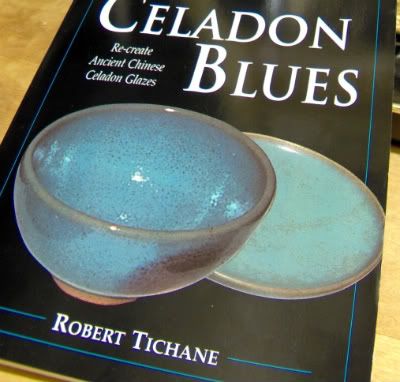In the "technical celadon education" department........
The "roots" for this whole celadon idea came to the potters from the earliest wood fired work, before the deliberate application of formulated glazes. Wood ash when combined with clay and fired over about 1200C will produce a glass. This is the genesis of the "shizenyu" on early wood fired work, a natural ash glaze deposit. On clays that contained iron, which most do, this ash glaze tended to disolve some iron out of the clay body .... often coloring it to a celadon green.
The celadon glaze gains it's unique jade-like color from a very small percentage of iron oxide included in the glaze batch formulation. In the earliest deliberately glazed work this iron likely was introduced into the mixture as an impurity in the clay material that was a standard ingredient in early feldspathic and wood ash based glazes. Most clays contain a bit of iron oxide that is picked up in the weathering process as the clay is created out of the granitic parent rock and transported by water and wind.
When fired in an oxygen starved atmosphere at exactly the correct time in the kiln, the iron oxide changes state, losing oxygen atoms to the cabon monoxide circulating in the kiln. This changes the iron oxide away from its typical reddish coloration. The chemist's term for this process is called "reduction"... the removing of oxygen from a compound. Early solid fuel kilns had very inefficient firebox designs, and because of this tended to produce reducing conditions inherently, so the discovery of this effect on iron should have been only a matter of time.
Controling the precise tone of the glaze certainly involved more experimentation on the part of the potters. The balance of the exact chemistry of the glass can impact the color rendition of the glaze from an icy blue to a deep grey green. This other chemistry also impacts the surface qualities of the glass....... high gloss or satin. The timing and intensity of the reducing atmosphere also affects color development. Too complicated to go into here

.
The amount of iron present also impacts the color. The percentage of iron oxide in celadons is typically about 1/2 percent to 3 1/2 percent of the total glaze batch. When the iron gets up into the 4 to 7 percent range, the same glaze batch glaze will go to what the Japanese call an "Ame"....or "candy". That is sort of a clear caramel looking color. And as you get into the 7 - 10 percent range you get the tenmoku and iron percipitate reds (depending again on the chemistry of the base glass).
Art historians often classify certain pieces as "yellow celadon". Yellow celadon is exactly the same glaze as green or blue celadon. If is just fired in oxidation. The question I always have when I see this labeling is was this a deliberate effect the potters were trying to achieve? Or was this a piece that when unloading the kiln the potter said, "
Darn, didn't get the firing right again!" 
I'll see if I can get a couple of pictures of my Sung celadon pieces up here.
best,
............john














